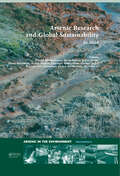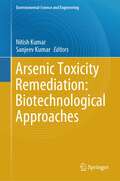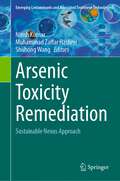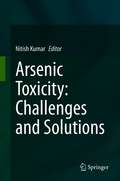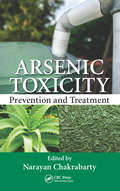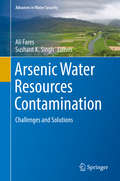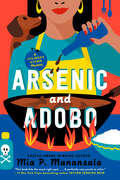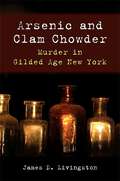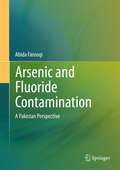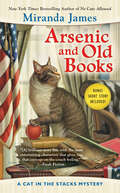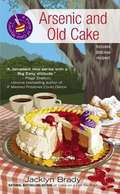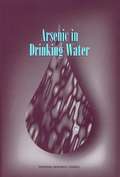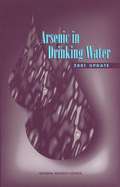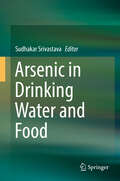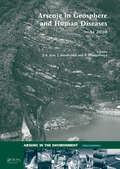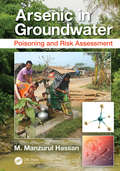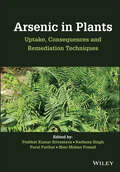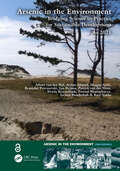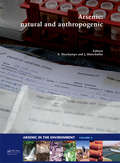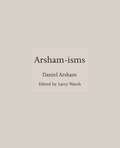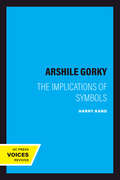- Table View
- List View
Arsenic Research and Global Sustainability: Proceedings of the Sixth International Congress on Arsenic in the Environment (As2016), June 19-23, 2016, Stockholm, Sweden (Arsenic in the Environment - Proceedings)
by Jochen Bundschuh Prosun Bhattacharya Arslan Ahmad Ravi Naidu Marie Vahter Jerker Jarsjö Jurate Kumpiene Charlotte Sparrenbom Gunnar Jacks Marinus Eric DonselaarThe Congress "Arsenic in the Environment" offers an international, multi- and interdisciplinary discussion platform for research and innovation aimed towards a holistic solution to the problem posed by the environmental toxin arsenic, with considerable societal impact. The congress has focused on cutting edge and breakthrough research in physical, chemical, toxicological, medical, agricultural and other specific issues on arsenic across a broader environmental realm. The Congress "Arsenic in the Environment" was first organized in Mexico City (As2006) followed by As2008 in Valencia, Spain, As2010 in Tainan, Taiwan, As2012 in Cairns, Australia and As2014 in Buenos Aires, Argentina. The 6th International Congress As2016 was held June 19-23, 2016 in Stockholm, Sweden and was entitled Arsenic Research and Global Sustainability. The Congress addressed the broader context of arsenic research along the following themes:Theme 1: Arsenic in Environmental Matrices and Interactions (Air, Water, Soil and Biological Matrices)Theme 2: Arsenic in Food ChainTheme 3: Arsenic and HealthTheme 4: Clean Water Technology for Control of ArsenicTheme 5: Societal issues, Policy Studies, Mitigation and ManagementLong term exposure to low-to-medium levels of arsenic via contaminated food and drinking water can have a serious impact on human health and globally, more than 100 million people are at risk. Since the end of the 20th century, arsenic in drinking water (mainly groundwater) has emerged as a global health concern. In the past decade, the presence of arsenic in plant foods – especially rice – has gained increasing attention. In the Nordic countries in particular, the use of water-soluble inorganic arsenic chemicals (e.g. chromated copper arsenate, CCA) as wood preservatives and the mining of sulfidic ores have been flagged as health concern. The issue has been accentuated by discoveries of naturally occurring arsenic in groundwater, primarily in the private wells, in parts of the Fennoscandian Shield and in sedimentary formations, with potentially detrimental effects on public health. Sweden has been at the forefront of research on the health effects of arsenic, technological solutions for arsenic removal, and sustainable mitigation measures for developing countries. Hosting this Congress in Sweden was also relevant because historically Sweden has been one of the leading producer of As2O3 and its emission from the smelting industries in northern Sweden and has successfully implemented actions to reduce the industrial emissions of arsenic as well as minimizing the use of materials and products containing arsenic in since 1977. The Congress has gathered professionals involved in different segments of interdisciplinary research in an open forum, and strengthened relations between academia, industry, research laboratories, government agencies and the private sector to share an optimal atmosphere for exchange of knowledge, discoveries and discussions about the problem of arsenic in the environment and catalyze the knowledge generation and innovations at a policy context to achieve the goals for post 2015 Sustainable Development.
Arsenic Toxicity Remediation: Biotechnological Approaches (Environmental Science and Engineering)
by Nitish Kumar Sanjeev KumarArsenic contamination in drinking water and associated adverse outcomes is one of the major health issues in more than 50 countries worldwide. The scenario is getting even more detrimental with increasing number of affected people and newer sites reported from all over the world. Apart from drinking water, the presence of arsenic has been found in various other dietary sources. Threatening the health of millions of people due to arsenic’s toxicity and carcinogenicity, the major routes of arsenic exposure for humans are either through drinking water or crops. This edited volume brings together a diverse group of environmental science, sustainability, and health researchers to address the challenges posed by global mass poisoning caused by arsenic water contamination. The book sheds light on this global environmental issue and proposes solutions to aquatic contamination through multi-disciplinary sustainable approaches and case studies from different parts of world. This book addresses the problem of arsenic by pursuing a holistic approach. It presents the status quo in different parts of the world and provides essential information on food-related arsenic exposure risks for humans and possible preventive and curative measures for tackling arsenic poisoning. The mechanisms of arsenic uptake, translocation, and distribution in plants and grains are also explained. In closing, the book reviews a variety of prospective sustainable solutions to the problem of arsenic accumulation in soil and water.The book comprises three sections. First section describes the routes of exposure to environmental arsenic and its transport in soil and aquatic ecosystems including its source and distribution in specific locations. Second section explains the health risks linked to arsenic exposure in food and the environment. Third section addresses sustainable arsenic contamination mitigation strategies using the potential applications of recent biotechnological techniques, bioremediation, phytoremediation, genetic engineering, nanotechnology, and in silico approaches.The book is intended for a broad audience including researchers, scientists, and readers with diverse backgrounds including agriculture, environmental science, food science, environmental management, and human health. It can also be used as an important reference guide for undergraduate and graduate students, university faculties, and environmentalists. The book may serve as a reference to environment and sustainability researchers, students, and policy makers.
Arsenic Toxicity Remediation: Sustainable Nexus Approach (Emerging Contaminants and Associated Treatment Technologies)
by Nitish Kumar Muhammad Zaffar Hashmi Shuhong WangArsenic contamination in drinking water and crops is a major health issue in many countries worldwide, threatening the health of millions of people due to arsenic’s toxicity and carcinogenicity. This edited volume brings together a diverse group of environmental science, sustainability and health researchers to address the challenges posed by arsenic contamination. The book sheds light on this global environmental issue and proposes solutions to aquatic contamination through multi-disciplinary sustainable approaches and case studies from different parts of the world. The chapters contained here present the status quo in different parts of the world and provide essential information on arsenic exposure risks for humans as well as possible measures for tackling arsenic poisoning. The mechanisms of arsenic uptake, translocation and distribution in plants and grains are also explained. In closing, the book reviews a variety of prospective sustainable solutions to the problem of arsenic accumulation in soil and water. The book is comprised of three sections. The first section describes the routes of exposure to environmental arsenic and its transport in soil and aquatic ecosystems. The second section explains the health risks linked to arsenic exposure in food and the environment. The third section addresses sustainable arsenic contamination mitigation strategies using the potential applications of recent biological technology such as biotechnology, bioremediation, phytoremediation, biochar, absorbent, genetic engineering, and nanotechnology approaches. The book is intended for a broad audience including researchers, scientists, and readers with diverse backgrounds.
Arsenic Toxicity: Challenges and Solutions
by Nitish KumarArsenic (As) is a widely distributed element in the environment having no known useful physiological function in plants or animals. Historically, this metalloid has been known to be used widely as a poison. Effects of arsenic have come to light in the past few decades due to its increasing contamination in several parts of world, with the worst situation being in Bangladesh and West Bengal in India. This edited volume brings together diverse group of environmental science, sustainability and health researchers to address the challenges posed by global mass poisoning caused by arsenic water contamination. The book covers sources of arsenic contamination, and its impact on human health and on prospective remediation both by bioremediation and phytoremediation. Applications of advance techniques such as genetic engineering and nanotechnology are also discussed to resolve the issue of arsenic contamination in ground water and river basins. The book sheds light on this global environmental issue, and proposes solutions to remove contamination through a multi-disciplinary lens and case studies from Bangladesh and India. The book may serve as a reference to environment and sustainability researchers, students and policy makers. It delivers an outline to graduate, undergraduate students and researchers, as well as academicians who are working on arsenic toxicity with respect to remediation and health issues.
Arsenic Toxicity: Prevention and Treatment
by Narayan ChakrabartyThe most talked about metalloid in the modern world, arsenic affects the liver, kidney, and lungs; leads to cardiovascular diseases, cancer, and diabetes; and may cause blindness with long-time exposure. With naturally occurring arsenic boosted by mining and other industrial processes contaminating soil and drinking water, arsenic toxicity is a maj
Arsenic Water Resources Contamination: Challenges and Solutions (Advances in Water Security)
by Ali Fares Sushant K. SinghThis edited volume brings together a diverse group of environmental science, sustainability and health researchers to address the challenges posed by global mass poisoning caused by arsenic water contamination. The book sheds light on this global environmental issue, and proposes solutions to aquatic contamination through a multi-disciplinary lens and case studies from Bangladesh and India. The book may serve as a reference to environment and sustainability researchers, students and policy makers.Part one of the book describes the issue of arsenic contamination in ground water and river basins, including its source and distribution in specific locations in India. Part two explains the routes of exposure to environmental arsenic, its transport in aquatic ecosystems, and the health risks linked to arsenic exposure in food and the environment. Part three addresses sustainable arsenic contamination mitigation strategies and policies, the socioeconomic, demographic, cultural and psychological aspects of arsenic contamination, and the potential applications of GIS and remote sensing in providing solutions. Part four concludes by discussing the role of local and regional institutions in water resources management for a variety of issues including but not limited to arsenic contamination, and presents a case study in the Indus river basin in Pakistan to propose future contamination mitigation strategies.
Arsenic and Adobo (A Tita Rosie's Kitchen Mystery #1)
by Mia P. ManansalaOne of BuzzFeed’s Highly Anticipated Mystery Novels of 2021! The first book in a new culinary cozy series full of sharp humor and delectable dishes—one that might just be killer.... When Lila Macapagal moves back home to recover from a horrible breakup, her life seems to be following all the typical rom-com tropes. She's tasked with saving her Tita Rosie's failing restaurant, and she has to deal with a group of matchmaking aunties who shower her with love and judgment. But when a notoriously nasty food critic (who happens to be her ex-boyfriend) drops dead moments after a confrontation with Lila, her life quickly swerves from a Nora Ephron romp to an Agatha Christie case. With the cops treating her like she's the one and only suspect, and the shady landlord looking to finally kick the Macapagal family out and resell the storefront, Lila's left with no choice but to conduct her own investigation. Armed with the nosy auntie network, her barista best bud, and her trusted Dachshund, Longanisa, Lila takes on this tasty, twisted case and soon finds her own neck on the chopping block…
Arsenic and Clam Chowder: Murder in Gilded Age New York (Excelsior Editions)
by James D. LivingstonArsenic and Clam Chowder recounts the sensational 1896 murder trial of Mary Alice Livingston, a member of one of the most prestigious families in New York, who was accused of murdering her own mother, Evelina Bliss. The bizarre instrument of death, an arsenic-laced pail of clam chowder, had been delivered to the victim by her ten-year-old granddaughter, and Livingston was arrested in her mourning clothes immediately after attending her mother's funeral. In addition to being the mother of four out-of-wedlock children, the last born in prison while she was awaiting trial, Livingston faced the possibility of being the first woman to be executed in New York's new-fangled electric chair, and all these lurid details made her arrest and trial the central focus of an all-out circulation war then underway between Joseph Pulitzer's World and Randolph Hearst's Journal.The story is set against the electric backdrop of Gilded Age Manhattan. The arrival of skyscrapers, automobiles, motion pictures, and other modern marvels in the 1890s was transforming urban life with breathtaking speed, just as the battles of reformers against vice, police corruption, and Tammany Hall were transforming the city's political life. The aspiring politician Teddy Roosevelt, the prolific inventor Thomas Edison, bon vivant Diamond Jim Brady, and his companion Lillian Russell were among Gotham's larger-than-life personalities, and they all played cameo roles in the dramatic story of Mary Alice Livingston and her arsenic-laced clam chowder. In addition to telling a ripping good story, the book addresses a number of social and legal issues, among them capital punishment, equal rights for women, societal sexual standards, inheritance laws in regard to murder, gender bias of juries, and the meaning of "beyond a reasonable doubt."
Arsenic and Fluoride Contamination: A Pakistan Perspective (SpringerBriefs in Environmental Science)
by Abida FarooqiThis book presents an up-to-the-minute overview of arsenic and fluoride pollution of soil and groundwater in Pakistan. It includes the author's doctoral dissertation on Lahore as a case study and describes the mechanism of pollution on the basis of the findings in that area. The book highlights the concrete situation in Pakistan - including the severity of the problem, its health effects and the risks posed to the people living in affected areas by these two major pollutants- and points out essential research areas that call for immediate attention. As such, it draws attention to the need for management strategies in the affected areas and offers a valuable reference work on Pakistan for students and researchers alike.
Arsenic and Old Books
by Miranda JamesIn Athena, Mississippi, librarian Charlie Harris is known for his good nature--and for his Maine coon cat Diesel that he walks on a leash. Charlie returned to his hometown to immerse himself in books, but taking the plunge into a recent acquisition will have him in over his head... Lucinda Beckwith Long, the mayor of Athena, has donated a set of Civil War-era diaries to the archives of Athena College. The books were recently discovered among the personal effects of an ancestor of Mrs. Long's husband. The mayor would like Charlie to preserve and to substantiate them as a part of the Long family legacy--something that could benefit her son, Beck, as he prepares to campaign for the state senate. Beck's biggest rival is Jasper Singletary. His Southern roots are as deep as Beck's, and their families have been bitter enemies since the Civil War. Jasper claims the Long clan has a history of underhanded behavior at the expense of the Singletarys. He'd like to get a look at the diaries in an attempt to expose the Long family's past sins. Meanwhile, a history professor at the college is also determined to get her hands on the books in a last-ditch bid for tenure. But their interest suddenly turns deadly... Now Charlie is left with a catalog of questions. The diaries seem worth killing for, and one thing is certain: Charlie will need to be careful, because the more he reads, the closer he could be coming to his final chapter...
Arsenic and Old Cake
by Jacklyn BradyBlind man's bluff With business going stale at Zydeco Cakes, Rita Lucero has plenty to worry about. But when the blind trumpet player Old Dog Leg Magee asks for a favor, she can't say no. His brother Monroe disappeared forty years ago, and now someone has shown up claiming to be him. Old Dog Leg needs Rita to be his eyes--and see if it's really his brother. The Twisted Palms Bed and Breakfast is full of unsavory characters, Monroe included. Posing as newlyweds, Rita and her friend Gabriel check in, only to discover that Monroe's true identity isn't the only mystery they'll have to solve. When another guest at the Twisted Palms turns up dead, it seems the mysterious man might also be a murderer...
Arsenic in Drinking Water
by National Research CouncilThe U.S. Environmental Protection Agency (EPA) has been considering a more stringent regulation of arsenic in water. A significant reduction in the maximum contaminant level (MCL) could increase compliance costs for water utilities. This book discusses the adequacy of the current EPA MCL for protecting human health in the context of stated EPA policy and provides an unbiased scientific basis for deriving the arsenic standard for drinking water and surface water.Arsenic in Drinking Water evaluates epidemiological data on the carcinogenic and noncarcinogenic health effects of arsenic exposure of Taiwanese populations and compares those effects with the effects of arsenic exposure demonstrated in other countries—including the United States.The book also reviews data on toxicokinetics, metabolism, and mechanism and mode of action of arsenic to ascertain how these data could assist in assessing human health risks from arsenic exposures. This volume recommends specific changes to improve the toxicity analyses and risk characterization. The implications of the changes for EPA’s current MCL for arsenic are also described.
Arsenic in Drinking Water
by Subcommittee on Arsenic in Drinking WaterThe U.S. Environmental Protection Agency (EPA) has been considering a more stringent regulation of arsenic in water. A significant reduction in the maximum contaminant level (MCL) could increase compliance costs for water utilities. This book discusses the adequacy of the current EPA MCL for protecting human health in the context of stated EPA policy and provides an unbiased scientific basis for deriving the arsenic standard for drinking water and surface water.Arsenic in Drinking Water evaluates epidemiological data on the carcinogenic and noncarcinogenic health effects of arsenic exposure of Taiwanese populations and compares those effects with the effects of arsenic exposure demonstrated in other countries—including the United States.The book also reviews data on toxicokinetics, metabolism, and mechanism and mode of action of arsenic to ascertain how these data could assist in assessing human health risks from arsenic exposures. This volume recommends specific changes to improve the toxicity analyses and risk characterization. The implications of the changes for EPA’s current MCL for arsenic are also described.
Arsenic in Drinking Water
by Subcommittee to Update the 1999 Arsenic in Drinking Water ReportHaving safe drinking water is important to all Americans. The Environmental Protection Agency's decision in the summer of 2001 to delay implementing a new, more stringent standard for the maximum allowable level for arsenic in drinking water generated a great deal of criticism and controversy. Ultimately at issue were newer data on arsenic beyond those that had been examined in a 1999 National Research Council report. EPA asked the National Research Council for an evaluation of the new data available.The committee's analyses and conclusions are presented in Arsenic in Drinking Water: 2001 Update. New epidemiological studies are critically evaluated, as are new experimental data that provide information on how and at what level arsenic in drinking water can lead to cancer. The report's findings are consistent with those of the 1999 report that found high risks of cancer at the previous federal standard of 50 parts per billion. In fact, the new report concludes that men and women who consume water containing 3 parts per billion of arsenic daily have about a 1 in 1,000 increased risk of developing bladder or lung cancer during their lifetime.
Arsenic in Drinking Water and Food
by Sudhakar SrivastavaArsenic contamination poses a major environmental problem, especially in Southeast Asian countries like Bangladesh and India. Threatening the health of millions of people due to arsenic’s toxicity and carcinogenicity, the major routes of arsenic exposure for humans are either through drinking water or crops. Rice is the crop most affected by arsenic owing to its cultivation in major arsenic contaminated areas, biogeochemical factors in the soil during rice growth, and specific features of rice that enable it take up more arsenic than other crop plants. This book addresses the problem of arsenic by pursuing a holistic approach. It presents the status quo in different parts of the world (North and South America, Europe, Asia, etc.) and provides essential information on food-related arsenic exposure risks for humans, and possible preventive and curative measures for tackling arsenic poisoning. It covers the arsenic contamination status of rice, rice-based products, other vegetables, fishes, mushrooms, and other foods, with a special focus on rice-arsenic interactions. The mechanisms of arsenic uptake, translocation and distribution in plants and grains are also explained. In closing, the book reviews a variety of prospective agronomic and biotechnological solutions to the problem of arsenic accumulation in rice grains. The book is intended for a broad audience including researchers, scientists, and readers with diverse backgrounds including agriculture, environmental science, food science, environmental management, and human health. It can also be used as an important reference guide for undergraduate and graduate students, university faculties, and environmentalists.
Arsenic in Geosphere and Human Diseases; Arsenic 2010: Proceedings of the Third International Congress on Arsenic in the Environment (As-2010) (Arsenic in the Environment - Proceedings)
by Jochen Bundschuh Prosun Bhattacharya Jiin-Shuh JeanThe congress "Arsenic in the Environment" offers an international, multi- and interdisciplinary discussion platform for arsenic research aimed at short-term solutions of problems with considerable social impact, rather than only focusing on cutting edge and breakthrough research in physical, chemical, toxicological, medical and other specific issue
Arsenic in Groundwater: Poisoning and Risk Assessment
by M. Manzurul HassanArsenic-contaminated groundwater is considered one of the world’s largest environmental health crises, as more than 300 million people in more than one-third of countries worldwide are at risk of groundwater arsenic poisoning. This book addresses how arsenic in groundwater impacts human health by using the frameworks of natural sciences, social sciences, and health sciences in the context set by environmental and legal considerations. Arsenic in Groundwater: Poisoning and Risk Assessment examines the spatial, quantitative, and qualitative aspects on arsenic poisoning; for instance, using geographical information systems (GIS) to investigate the spatial discontinuity of arsenic-laced water in spatial and temporal dimensions to uncover patterns of variations over scales from meters to kilometers. Spatial risk mapping provides insight for academics, researchers, policy makers, and politicians on possible long-term strategies for arsenic mitigation. Qualitative methodological approaches uncover the hidden issues of arsenic poisoning on human health and the related social implications. The book also examines legal aspects, such as the right to safe drinking water, as well as an in-depth look at how community participation can shape public policy. Features: Describes arsenic poisoning from both the scientific and social science perspectives Includes technical insights drawn from GIS-based modeling for spatial arsenic discontinuity and spatial health risks of arsenic poisoning Provides a state-of-the-art review of the human health literature and cutting-edge scientific evidence for arsenic-related health and social implications Examines the environmental justice and legal issues of drinking water and its quality Presents environmental policy and public mitigation strategies with Public Participation GIS (PPGIS) related to arsenic contamination More than 2,000 references serve as valuable resources for various aspects of arsenic poisoning
Arsenic in Plants: Uptake, Consequences and Remediation Techniques
by Parul Parihar Sheo Mohan Prasad Prabhat Kumar Srivastava Rachana SinghArsenic in Plants Comprehensive resource detailing the chemistry, toxicity and impact of arsenic in plants, and solutions to the problem Arsenic in Plants: Uptake, Consequences and Remediation Techniques provides comprehensive coverage of the subject, detailing arsenic in our environment, the usage of arsenicals in crop fields, phytotoxicity of arsenic and arsenic’s impact on the morphology, anatomy and quantitative and qualitative traits of different plant groups, including their physiology and biochemistry. The work emphasizes the occurrence of arsenic, its speciation and transportation in plants, and differences in mechanisms of tolerance in hyper-accumulator and non-accumulator plants. Throughout the text, the highly qualified authors delve into every facet of the interaction of arsenic with plants, including the ionomics, genomics, transcriptomics and proteomics in relation to arsenic toxicity, impact of exogenous phytohormones and growth-regulating substances, management of arsenic contamination in the soil-plant continuum, phytoremediation of arsenic toxicity and physical removal of arsenic from water. General discussion has also been included on subjects such as the ways through which this metalloid affects plant and human systems. Topics covered include: Introduction and historical background of arsenic and the mechanism of arsenic transport and metabolism in plants Arsenic-induced responses in plants, including impact on biochemical processes and different plant groups, from cyanobacteria to higher plants The role of phytohormones, mineral nutrients, metabolites and signaling molecules in regulating arsenic-induced toxicity in plants Genomic, proteomic, metabolomic, ionomic and transcriptional regulation during arsenic stress Strategies to reduce the arsenic contamination in soil-plant systems and arsenic removal by phytoremediation techniques Researchers, academics, and students of plant physiology, biotechnology, and agriculture will find valuable information in Arsenic in Plants to understand this pressing subject in full, along with its implications and how we can adapt our strategies and behaviors to promote reduced contamination through practical applications.
Arsenic in the Environment: Proceedings of the 8th International Congress and Exhibition on Arsenic in the Environment (As2021), June 7-9, 2021, Wageningen, The Netherlands (Arsenic in the Environment - Proceedings)
by Dragan Savic Jochen Bundschuh Prosun Bhattacharya Arslan Ahmad Ravi Naidu Branislav Petrusevski Jan Weijma Erwin Beerendonk van der Wal, Albert van der Wens, PatrickThe Congress and Exhibition Series "Arsenic in the Environment" offers an international, multi- and interdisciplinary discussion platform for research and innovation aimed towards a holistic solution to the challenges posed by the environmental toxin arsenic, with global societal impact. The Congress has focused on cutting edge and breakthrough research in physical, chemical, toxicological, medical, agricultural and other specific issues on arsenic across a broader environmental realm. The Biennial Congress and Exhibition "Arsenic in the Environment" was first organized in Mexico City (As2006) followed by As2008 in Valencia (Spain), As2010 in Tainan (Chinese Taiwan), As2012 in Cairns (Australia), As2014 in Buenos Aires (Argentina), As2016 in Stockholm (Sweden) and As2018 in Beijing (P.R. China).The 8th International Congress As2020 was held June 7-9, 2021 (first time digitally owing to the global COVID-19 pandemic, in Wageningen, The Netherlands) and with a title Arsenic in the Environment - Bridging Science to Practice for Sustainable Development. The Congress addressed the broader context of arsenic research aligned on the following themes:Theme 1: Arsenic in Natural Soil and Water SystemsTheme 2: Arsenic in Agriculture and Food ProductionTheme 3: Health Impacts of ArsenicTheme 4: Technologies for Arsenic Removal from WaterTheme 5: Sustainable Mitigation and Management for Sustainable DevelopmentArsenic in drinking water and food is a major health issue, affecting millions of people in many parts of the world. In recent years serious cases of arsenic exposure through different environmental matrices have been reported from, for example, Argentina, Bangladesh, Chile, China, Taiwan, Turkey, India, Mexico, UK, USA, Pakistan, Vietnam as well as other regions in the world. Arsenic can cause a number of carcinogenic and non-carcinogenic adverse effects on human health and therefore human exposure to arsenic should be avoided. Notably, The Netherlands has been in the forefront of research on arsenic removal technology and developed a cutting edge innovation to remove arsenic to levels below the WHO drinking water guideline to as low as less than 1 μg/L. This has created an enabling environment to discuss on policy issues for defining the new drinking water guideline. The Congress has attracted professionals involved in different segments of interdisciplinary research on arsenic in an open forum, and strengthened relations between academia, research institutions, government and non-governmental agencies, industries, and civil society organizations to share an optimal ambience for exchange of knowledge.
Arsenic with Austen (A Crime with the Classics Mystery)
by Katherine Bolger HydeWhen Emily Cavanaugh inherits a fortune from her great aunt, she expects her life to change. She doesn't expect to embark on a murder investigation, confront the man who broke her heart 35 years before, and nearly lose her own life. <p><p> Emily travels to the sleepy coastal village of Stony Beach, Oregon, to claim her inheritance, centered in a beautiful Victorian estate called Windy Corner but also including a substantial portion of the real estate of the whole town. As she gets to know the town's eccentric inhabitants--including her own once-and-possibly-future love, Sheriff Luke Richards--she learns of a covert plan to develop Stony Beach into a major resort. She also hears hints that her aunt may have been murdered. Soon another suspicious death confirms this, and before long Emily herself experiences a near-fatal accident. <p> Meanwhile, Emily reads Persuasion, hoping to find belated happiness with her first love as Anne Elliot did with Captain Wentworth. She notices a similarity between her not-quite-cousin Brock Runcible, heir to a smaller portion of her aunt's property, and Mr. Elliot in Persuasion, and her suspicions of Brock crystallize. But as she and Luke continue to investigate and events speed toward a climax, Emily realizes that underneath the innocent-looking rocks of Stony Beach lurk festering jealousies that would have shocked even the worst of Jane Austen's charming reprobates.
Arsenic with Austen: A Mystery (Crime with the Classics #1)
by Katherine Bolger Hyde“A cleverly-constructed village mystery, filled with hidden treats for Jane Austen fans and mystery lovers alike.” —John Clement, author of the Dixie Hemingway seriesEmily Cavanaugh travels to the sleepy coastal village of Stony Beach, Oregon, to claim her inheritance, centered in a beautiful Victorian estate called Windy Corner. As she gets to know the town’s eccentric inhabitants—including her own once-and-possibly-future love, Sheriff Luke Richards—she learns of a plan to develop Stony Beach into a major resort. She also hears hints that her aunt may have been murdered. Soon another suspicious death confirms this, and before long Emily herself experiences a near-fatal accident.Meanwhile, Emily reads Persuasion, hoping to find belated happiness with her first love as Anne Elliot did with Captain Wentworth. She notices a similarity between her not-quite-cousin Brock Runcible, heir to a smaller portion of her aunt’s property, and Mr. Elliot in Persuasion, and her suspicions of Brock crystallize. But as she and Luke continue to investigate, Emily realizes that underneath the innocent-looking rocks of Stony Beach lurk festering jealousies that would have shocked even the worst of Jane Austen’s charming reprobates.“An intelligent traditional mystery that stars an endearing woman of a certain age who draws on her knowledge of literature to solve crimes.” —Library Journal“Arsenic with Austen—what’s not to love in crime solved by a classic?” —Cara Black, New York Times–bestselling author of the Aimée Leduc series“Murders are solved handily, and first love is reignited in this contemporary cozy with a literary bent . . . An engaging start to a series by debut-novelist Hyde.” —Booklist
Arsenic: Natural and Anthropogenic (Arsenic in the environment)
by Jörg Matschullat Eleonora DeschampsThe discussion on arsenic in the environment is complex and must grasp the importance of very many, mostly unrelated works on individual aspects. This volume represents one of the first comprehensive and interdisciplinary examinations into arsenic's behaviour in air, water, soils, sediments, plants and the human body. Based on state-of-the-art investigations into the global arsenic cycle, the related human toxicology and available remediation technologies, arsenic is assessed holistically in all the environmental compartments. Using the results of primary research, the authors offer concrete suggestions for risk reduction and management of environmental pollution that allow the reader to successfully tackle similar problems and find sustainable solutions.
Arsham-isms (ISMs)
by Daniel ArshamA collection of compelling quotations from a rising star in contemporary art, architecture, and designThe work of renowned contemporary artist Daniel Arsham blurs the lines between art, architecture, archeology, and design. In his distinctive style, he takes ancient art works and objects from twentieth-century pop culture and casts sculptures of them in geological materials such as quartz or volcanic ash, colliding past, present, and future in haunted yet playful visions that prompt viewers to question their everyday surroundings. Gathered from interviews and other sources, Arsham-isms is a collection of lively, thought-provoking, and memorable quotations from this exciting young creative talent on a wide range of subjects—including art, architecture, film, design, pop culture, the art world, and what it means to be a globally recognized artist today.Select quotations from the book:“Art needs to be a little dangerous.”“You don’t have to own the thing to be part of it.”“This work for me is not about progress. It is about destruction and growth and where they are able to meet in the middle.”
Arshile Gorky: His Life and Work
by Hayden HerreraFrom the Author of Frida, the Moving and Heroic Story of One of the Central Painters of the Twentieth CenturyBorn in Turkey around 1900, Vosdanik Adoian escaped the massacres of Armenians in 1915 only to watch his mother die of starvation and his family scatter in their flight from the Turks. Arriving in America in 1920, Adoian invented the pseudonym Arshile Gorky-and obliterated his past. Claiming to be a distant cousin of the novelist Maxim Gorky, he found work as an art teacher and undertook a program of rigorous study, schooling himself in the modern painters he most admired, especially Cézanne and Picasso. By the early forties, Gorky had entered his most fruitful period and developed the style that is seen as the link between European modernism and American abstract expressionism. His masterpieces influenced the great generation of American painters in the late forties, even as Gorky faced a series of personal catastrophes: a studio fire, cancer, and a car accident that temporarily paralyzed his painting arm. Further demoralized by the dissolution of his seven-year marriage, Gorky hanged himself in 1948.A sympathetic, sensitive account of artistic and personal triumph as well as tragedy, Hayden Herrera's biography is the first to interpret Gorky's work in depth. The result of more than three decades of scholarship-and a lifelong engagement with Gorky's paintings-Arshile Gorky traces the progress from apprentice to master of the man André Breton called "the most important painter in American history."
Arshile Gorky: The Implications of Symbols
by Harry RandThis title is part of UC Press's Voices Revived program, which commemorates University of California Press’s mission to seek out and cultivate the brightest minds and give them voice, reach, and impact. Drawing on a backlist dating to 1893, Voices Revived makes high-quality, peer-reviewed scholarship accessible once again using print-on-demand technology. This title was originally published in 1991.This title is part of UC Press's Voices Revived program, which commemorates University of California Press’s mission to seek out and cultivate the brightest minds and give them voice, reach, and impact. Drawing on a backlist dating to 1893, Voices Revived</DIV
